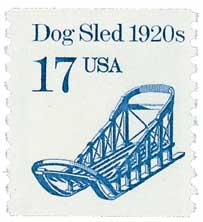
# 4374 - 2009 42c Alaska Statehood
Alaska Statehood
Issue Date: January 3, 2009
First-day City: Anchorage, AK
Untamed Arctic beauty is captured on the 2009 U.S. stamp honoring 50 years of Alaska statehood. The woodcut cachet pictures Sitka, a seaside village that was once the capital of Alaska.
Breaking with the U.S.P.S. tradition of not picturing living people on U.S. stamps, the design uses a photograph of DeeDee Jonrowe, taken as she competed in the 2000 Iditarod Trail Sled Dog Race.
From the majesty of the mountain peaks to Jonrowe herself, the stamp captures the rugged Alaskan spirit. At the age of 49, the hearty Alaskan resident competed in the grueling race just three weeks after completing chemotherapy for breast cancer in 2003.
The Iditarod commemorates the 1925 “Great Race of Mercy,” when a diphtheria epidemic threatened Nome. When modern transportation failed, twenty teams of “mushers” and about 150 sled dogs relayed the serum over 674 miles from Anchorage to Nome to save thousands of lives.
Also known as the “Land of the Midnight Sun,” Alaska was purchased from Russia in 1867 for $7.2 million. The discovery of gold brought thousands of people to the territory during the late 1800s. In 1959, Alaska became the 49th state admitted to the union. Nearly 65% of the state is managed by the U.S. government as public land and national parks.
Alaska’s Final Dog Sled Mail Route
Mail delivery in Alaska has long been more of a challenge than in other parts of the United States. The extreme temperatures and long stretches of undeveloped land in the 1800s made mail delivery difficult.
Letters sent from the continental US could take weeks or even months to reach their destinations. Often, mail would be sent to Washington where it was loaded on to steamships in the Puget Sound. These ships would then carry the mail to southeastern coastal towns. From there, the mail was transported into the interior sections of Alaska by river steamers and later trains. However, trains couldn’t reach some of the most remote areas and ships couldn’t pass frozen rivers, so other methods of delivery were needed.
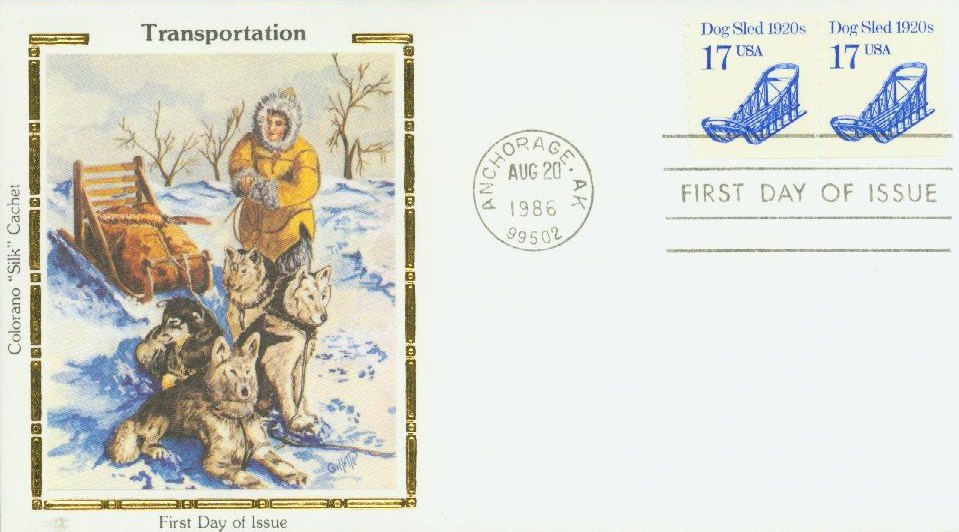
Sled dogs proved to be the answer. They could travel long distances day or night, over frozen lakes and through dark forests. Native malamutes, huskies and Eskimo dogs were a natural choice. They were strong, had thick coats, furry paws, and didn’t need special housing. At one point they tried using horses, but their feed was expensive and they couldn’t handle the cold as well.
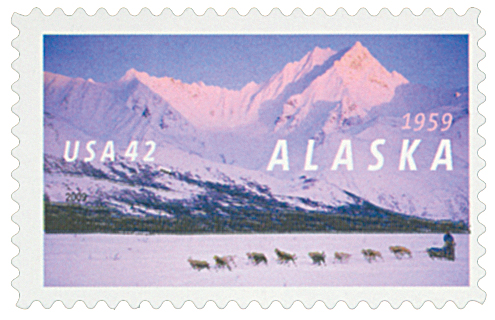
Most dog sled teams consisted of eight to ten dogs pulling sleds carrying between 500 and 700 pounds of mail. The mail was carried in rubber-lined waterproof bags and the dogs wore moose hide moccasins to protect their feet from sharp ice.
By 1901, Alaska had a system of mail trails that ran along almost the entire length of the Yukon River. Much of the mail was carried along the 2,300-mile Iditarod Trail from Seward to Nome.

Dog sled mail delivery made a huge difference to the people of Alaska and it was widely in use for the first three decades of the 20th century. Then in the 1930s, airplanes slowly began to replace dog sled mail. The change was relatively quick and smooth in aviation centers such as Fairbanks. But it was a much longer process in the more remote areas where they needed to develop airfields.
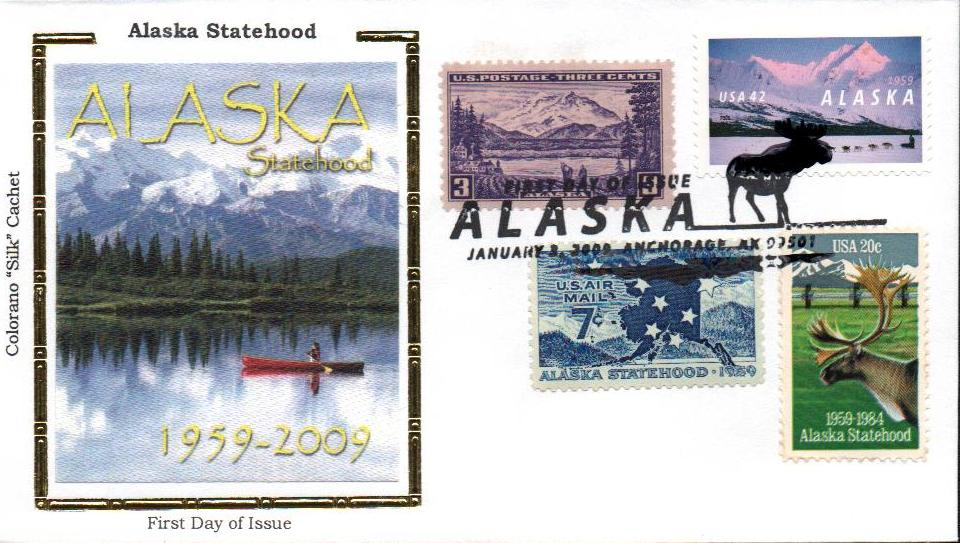
By the 1940s, most sled dog teams were replaced by airplanes. However, one sled dog team continued to operate into the 1960s. Chester Noongwook made weekly 100-mile mail runs from Gambell to Savoonga. Even as airstrips were built in both towns, he continued to carry the mail when the planes couldn’t make it in. He made his final trip on January 8, 1963.
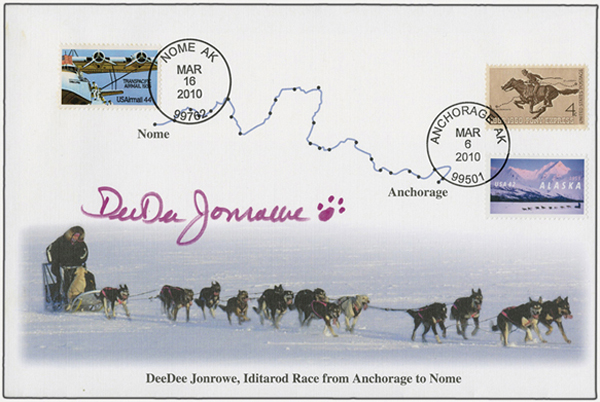
Upon his retirement, Noongwook was invited to Fairbanks, though he didn’t know why. Ironically, he was to fly to Fairbanks, but the plane was delayed by four hours due to poor weather. Once he finally arrived in Fairbanks, he was honored to receive a special award for being the last sled dog mail carrier.
Alaska Statehood
Issue Date: January 3, 2009
First-day City: Anchorage, AK
Untamed Arctic beauty is captured on the 2009 U.S. stamp honoring 50 years of Alaska statehood. The woodcut cachet pictures Sitka, a seaside village that was once the capital of Alaska.
Breaking with the U.S.P.S. tradition of not picturing living people on U.S. stamps, the design uses a photograph of DeeDee Jonrowe, taken as she competed in the 2000 Iditarod Trail Sled Dog Race.
From the majesty of the mountain peaks to Jonrowe herself, the stamp captures the rugged Alaskan spirit. At the age of 49, the hearty Alaskan resident competed in the grueling race just three weeks after completing chemotherapy for breast cancer in 2003.
The Iditarod commemorates the 1925 “Great Race of Mercy,” when a diphtheria epidemic threatened Nome. When modern transportation failed, twenty teams of “mushers” and about 150 sled dogs relayed the serum over 674 miles from Anchorage to Nome to save thousands of lives.
Also known as the “Land of the Midnight Sun,” Alaska was purchased from Russia in 1867 for $7.2 million. The discovery of gold brought thousands of people to the territory during the late 1800s. In 1959, Alaska became the 49th state admitted to the union. Nearly 65% of the state is managed by the U.S. government as public land and national parks.
Alaska’s Final Dog Sled Mail Route
Mail delivery in Alaska has long been more of a challenge than in other parts of the United States. The extreme temperatures and long stretches of undeveloped land in the 1800s made mail delivery difficult.
Letters sent from the continental US could take weeks or even months to reach their destinations. Often, mail would be sent to Washington where it was loaded on to steamships in the Puget Sound. These ships would then carry the mail to southeastern coastal towns. From there, the mail was transported into the interior sections of Alaska by river steamers and later trains. However, trains couldn’t reach some of the most remote areas and ships couldn’t pass frozen rivers, so other methods of delivery were needed.

Sled dogs proved to be the answer. They could travel long distances day or night, over frozen lakes and through dark forests. Native malamutes, huskies and Eskimo dogs were a natural choice. They were strong, had thick coats, furry paws, and didn’t need special housing. At one point they tried using horses, but their feed was expensive and they couldn’t handle the cold as well.

Most dog sled teams consisted of eight to ten dogs pulling sleds carrying between 500 and 700 pounds of mail. The mail was carried in rubber-lined waterproof bags and the dogs wore moose hide moccasins to protect their feet from sharp ice.
By 1901, Alaska had a system of mail trails that ran along almost the entire length of the Yukon River. Much of the mail was carried along the 2,300-mile Iditarod Trail from Seward to Nome.

Dog sled mail delivery made a huge difference to the people of Alaska and it was widely in use for the first three decades of the 20th century. Then in the 1930s, airplanes slowly began to replace dog sled mail. The change was relatively quick and smooth in aviation centers such as Fairbanks. But it was a much longer process in the more remote areas where they needed to develop airfields.

By the 1940s, most sled dog teams were replaced by airplanes. However, one sled dog team continued to operate into the 1960s. Chester Noongwook made weekly 100-mile mail runs from Gambell to Savoonga. Even as airstrips were built in both towns, he continued to carry the mail when the planes couldn’t make it in. He made his final trip on January 8, 1963.

Upon his retirement, Noongwook was invited to Fairbanks, though he didn’t know why. Ironically, he was to fly to Fairbanks, but the plane was delayed by four hours due to poor weather. Once he finally arrived in Fairbanks, he was honored to receive a special award for being the last sled dog mail carrier.











